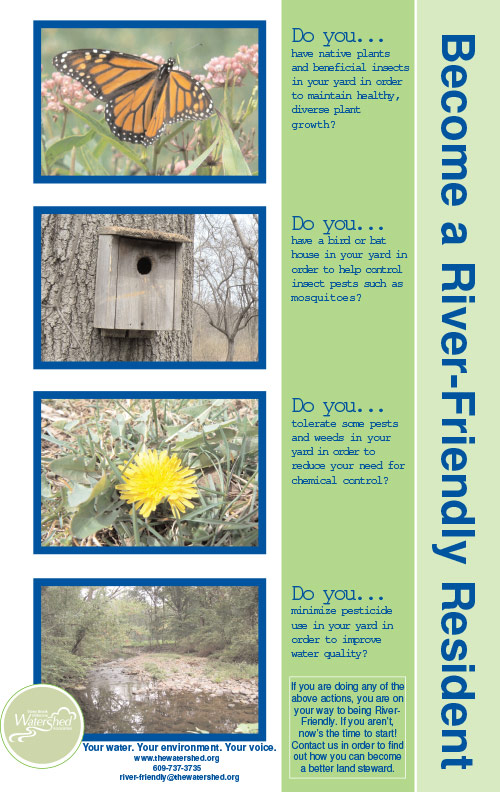Smarter Lawn Care, Cleaner Water
Green-Blue Grants Bring Home Healthier Landscapes
 |
|
In central New Jersey’s Stony Brook–Millstone Watershed, educational posters were displayed in buildings and libraries throughout 26 municipalities, with a combined population of approximately 300,000. |
Do you know where storm water goes when it leaves your yard? This question was posed to western Massachusetts home gardeners last summer as part of a program designed to show how lawn care practices can affect lakes, streams, rivers, and estuaries.
Residential lawns cover more than 20 million acres nationwide and receive more pesticide applications per acre than agricultural land. The EPA estimates that up to 70 percent of pollutants in surface waters are carried there by storm water runoff, so home landscaping decisions can have a huge impact on water quality.
The Massachusetts workshop was one of seven projects funded through the Northeastern IPM Center’s Green-Blue Grants Program, which disbursed $12,500 to promote clean water through residential integrated pest management. Nearly 1,000 homeowners and lawn care professionals in six states have received direct training through this program. Now, professionals are using their new knowledge on hundreds of clients’ lawns, while posters and brochures spread the word to many more residents in the region.
IPM by the Yard
In New Hampshire, landscapers and municipal decision makers attended a two-day program on ecologically based designs and low-impact landscaping practices. The training was then condensed for Extension volunteers, who taught homeowners to raise mowing heights, select grass species that require less fertilizer and water, and use other IPM strategies to protect the environment without sacrificing aesthetics.
Workshops for central New Jersey land care professionals included organic options and a special emphasis on the importance of communicating with clients. Homeowners also attended, and they engaged in open dialogue with the professionals. The exchange led many to plan further discussion with their own landscapers or to consider changing landscapers.
Delaware residents participated in two workshops that included education on using native plants to increase diversity and reduce the need for pesticide use.
In New York’s Putnam County, landscapers representing hundreds of clients were introduced to IPM lawn care. Two-thirds of participants said they’d reduce their use of herbicides, and all planned to offer more soil testing and zero-phosphorous fertilizers. In the state’s capital district, 225 residents attended presentations on healthy lawns, and 42 percent of respondents to a follow-up survey had adopted at least one IPM practice, such as choosing the right grass for their site.
In Southern Maine, 150 lawn care providers took a workshop aimed at reducing nutrients and pesticides in Casco Bay. More than 90 percent of participants said they would add or expand natural and low-input lawn care services, and most planned to change the amount, frequency, or timing of their company’s pesticide and fertilizer applications.
— by ELIZABETH MYERS
The Northeastern IPM Center promotes integrated pest management for reducing risks to human health and the environment. If republishing our news, please acknowledge the source (“From Northeast IPM Insights”) along with a link to our website.
